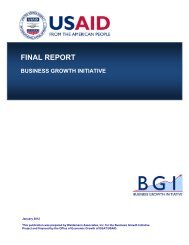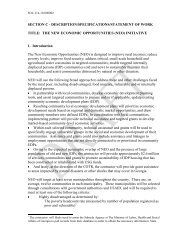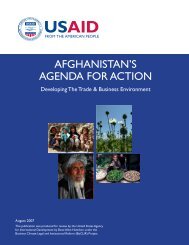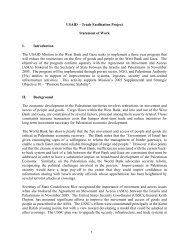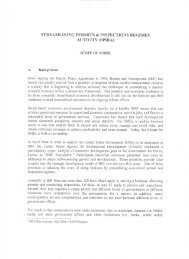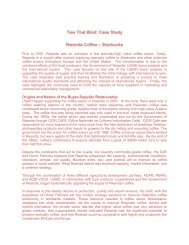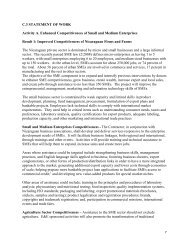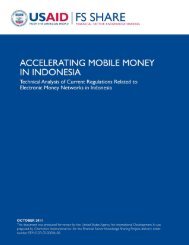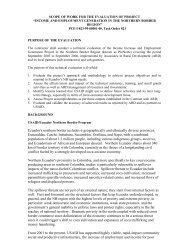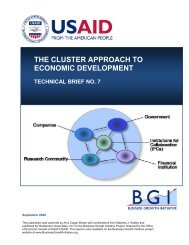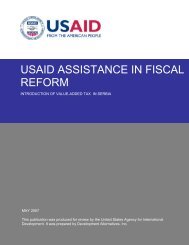Evaluation of the USAID-Kosovo SME and Agriculture - Economic ...
Evaluation of the USAID-Kosovo SME and Agriculture - Economic ...
Evaluation of the USAID-Kosovo SME and Agriculture - Economic ...
Create successful ePaper yourself
Turn your PDF publications into a flip-book with our unique Google optimized e-Paper software.
Development Associates, Inc.THE MAJOR CONSTRAINTS (annual <strong>and</strong> seasonal variations in precipitation <strong>of</strong> course canalways be a constraint on agricultural production).The 26.5% customs + V.A.T. + 1 to 5% transit taxes makes for one <strong>of</strong> <strong>the</strong> highest animalfeed costs in <strong>the</strong> world.It is very difficult to obtain credit for agribusiness investments.The laborious process <strong>of</strong> obtaining acceptance to <strong>the</strong> Ministry <strong>of</strong> <strong>Agriculture</strong>’s NationalSeed List on a timely basis in order to effect <strong>the</strong> importation <strong>of</strong> high quality seed byplanting time seriously hampers <strong>the</strong> introduction <strong>of</strong> new varieties.Cheap imports <strong>of</strong> outdated eggs, spent hens, <strong>and</strong> chicken legs from neighboring countrieswith strong farm subsidy programs puts <strong>Kosovo</strong> producers at serious cost disadvantage.There is a shortage <strong>of</strong> low cost processing capacity for oil seeds for long-termdevelopment.Lack <strong>of</strong> confidence in <strong>the</strong> Government’s capacity to promulgate policies <strong>and</strong> regulationsthat promote local <strong>Kosovo</strong> agribusinesses <strong>and</strong> farm production quells <strong>the</strong> incentive <strong>of</strong>farmers to try new technologies <strong>and</strong> investments. The border tax policies that place<strong>Kosovo</strong> farmers at a competitive disadvantage with farmers in neighboring countries is<strong>the</strong> policy that <strong>the</strong> farmers object to <strong>the</strong> most.IFDC has coordinated <strong>and</strong> worked well with associations such as KODAA, SHPUK, <strong>and</strong> AKA,<strong>and</strong> with o<strong>the</strong>r NGOs such as CARE. The IFDC staff has continually collaborated with <strong>the</strong> KBSstaff. The majority <strong>of</strong> <strong>the</strong> KBS cooperation has come with <strong>the</strong> training <strong>of</strong> poultry processors <strong>and</strong>feed millers <strong>and</strong> on food policy issues such as quality control st<strong>and</strong>ards.IMPACTIFDC/KFPP has had measured success in achieving <strong>the</strong> desired results set out in <strong>the</strong> sub-grantagreement to increase agricultural production <strong>and</strong> farm incomes in certain locations:Working closely with input suppliers, <strong>the</strong>y were able to increase <strong>the</strong> usage <strong>of</strong> fertilizer by1500 MT, quality seed by 200 MT, <strong>and</strong> farm chemicals (insecticides, herbicides <strong>and</strong>fungicides) by 11,000 liters. These are not spectacular numbers but <strong>the</strong>y are good start oncreating a program. Seeding rates <strong>and</strong> rates <strong>of</strong> application <strong>of</strong> fertilizers <strong>and</strong> pesticidesvary widely throughout <strong>the</strong> country <strong>and</strong> from farm to farm, based on <strong>the</strong> crop, <strong>the</strong> variety,<strong>the</strong> soil fertility, whe<strong>the</strong>r it is irrigated or rainfed <strong>and</strong> o<strong>the</strong>r factors. Averages are equallymeaningless. The increase in input sales boosted pr<strong>of</strong>its for <strong>the</strong> suppliers as well, alongwith an increase in additional labor.Linked to <strong>the</strong> input suppliers success, feed grain production increased within <strong>the</strong> groups<strong>of</strong> farmers resulting in 4,000 ha. being sown to quality feed grains, using recommendedinputs. This increased <strong>the</strong> aggregate marketable production <strong>of</strong> quality feed grain: maizeby 15,750 MT, soybeans-1,050MT <strong>and</strong> sunflower seed by 1,050 MT. The details <strong>of</strong> <strong>the</strong>seinitial efforts are spelled out in <strong>the</strong> projects progress reports <strong>and</strong> will not be repeated here.It is clear, however, <strong>the</strong> initial results <strong>of</strong> this program caused a direct increase on incomefor <strong>the</strong> participating farmers.<strong>Evaluation</strong> <strong>of</strong> <strong>the</strong> <strong>USAID</strong>/<strong>Kosovo</strong> <strong>SME</strong> 95 May 2004<strong>and</strong> <strong>Agriculture</strong>/Agribusiness ProgramsVolume I



